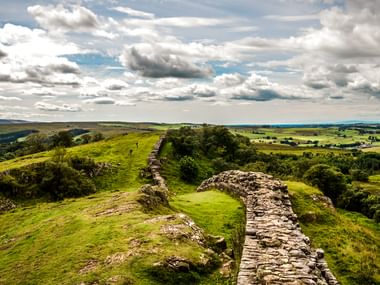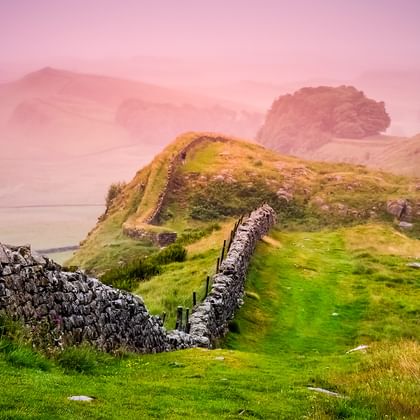Walk Through 2,000 Years of History at Hadrian’s Wall in England
Roman history set amidst England’s breathtaking landscapes
Hadrian’s Wall – or Hadrians mur, as it’s often called in Danish – is one of England’s most iconic walking routes, with origins dating back to the Roman Empire. The ancient wall was built during Emperor Hadrian’s reign in the 2nd century AD and stretches across northern England – from Wallsend near Newcastle upon Tyne in the east to Bowness-on-Solway on the Irish Sea coast in the west.
Although parts of Hadrian’s Wall have weathered over the centuries, there are still impressive remains of Roman forts, watchtowers, and castles, standing as a testament to the grandeur of ancient engineering and military discipline. Encountering these historic ruins against the backdrop of rolling, green landscapes makes the journey both a cultural and scenic experience.

A Walking Route Through Varied Terrain
Hadrian’s Wall Path stretches for over 135 kilometres, guiding you through a landscape that ranges from peaceful meadows and grassy hills to small villages where local culture and traditions thrive. Along the way, you can enjoy views of woodlands, fields, and rocky outcrops, following trails that in some places run right beside the ancient stone remains of Hadrian’s Wall.
The terrain is generally moderate, but you will encounter a few ascents that reward you with panoramic views over the Northumbrian highlands. This blend of history and natural beauty is one of the reasons why many consider Hadrian’s Wall to be one of the best walking routes in the UK.

Cultural Encounters and Local Specialties
Walking along Hadrian’s Wall also gives you the chance to connect with small communities, cosy pubs, and rural bed & breakfasts – all of which add to the charm and memorability of the journey. The locals are often very welcoming and eager to share stories about the region’s history and traditions.
You can sample everything from classic British comfort food like pie and mash to locally brewed ales – the perfect reward on a cool evening after a day on the trail. In several of the towns, you’ll also find museums and visitor attractions where you can delve deeper into the history of how and why the wall was built.

Planning and Practical Tips
Hadrian’s Wall is best walked between spring and autumn, when the weather is generally more stable – though you should always be prepared for sudden showers, as northern England’s weather can be unpredictable. Autumn can also be a beautiful season, with nature changing colour, but the days are shorter and temperatures cooler.
Make sure to bring a good jacket, sturdy hiking boots, and possibly trekking poles, especially if you’re a beginner or prefer extra support on the steeper sections.

A Journey in the Footsteps of Roman Legionaries
Walking along Hadrian’s Wall is not just about covering distance – it’s about stepping into Roman military history. You can almost sense the presence of the legionaries when standing by the remains of a watchtower, gazing out over the rolling hills, or when visiting one of the well-preserved forts such as Housesteads or Chesters. Every step is a reminder of the Romans’ remarkable ingenuity in defensive engineering, and of how the wall once marked the northernmost boundary of the mighty empire.

Take a Journey Through Time on Hadrian’s Wall
Walking along Hadrian’s Wall is a journey back in time, retracing the footsteps of the Romans. As you approach the western coast and the fresh sea air mixes with the scent of grass and earth, the walk draws to a close – but you are left with a unique insight into the Roman legacy that has shaped the region for nearly two millennia.
The Hadrian’s Wall walk offers both a physical challenge and a profound sense of history, making it a must for anyone who appreciates a rich cultural landscape and a journey into an era that still casts its shadow over modern-day Britain.

See Our Walking Holidays in England
See Our Walking Holidays in England

"We look forward to making your holiday dreams come true"


